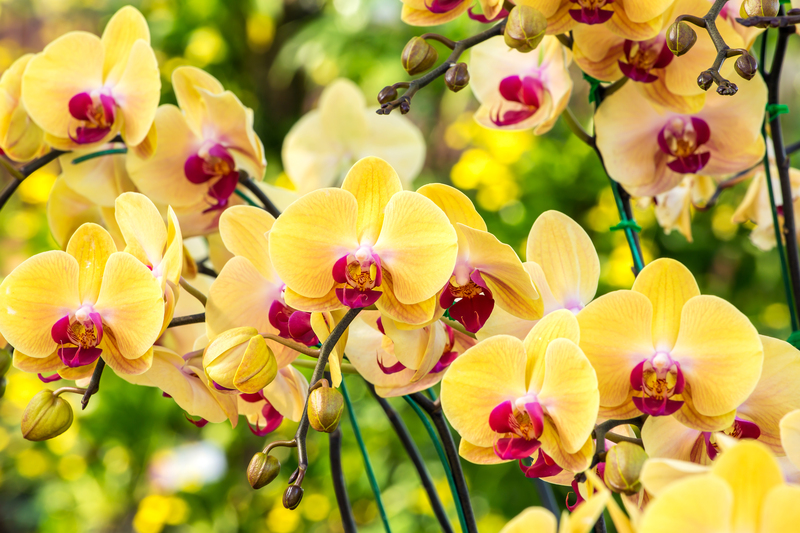The art of space-saving: Vertical gardening
Posted on 29/08/2025
The Art of Space-Saving: Vertical Gardening
Discover how the creative use of upward space is transforming urban gardening. Vertical gardening isn't just a trend--it's an art that redefines how we approach growing plants in modern, space-constrained environments.
Introduction to Vertical Gardening
Vertical gardening is an innovative gardening technique that maximizes limited spaces by growing plants upwards, rather than outwards. With urban living on the rise, more people are seeking ways to embrace greenery in apartments, balconies, or small patios. Vertical gardens not only cater to constrained spaces but also offer a visually striking and sustainable solution for healthier urban environments.
Understanding the Principles of Vertical Gardening
The core idea of vertical gardening lies in utilizing vertical surfaces such as walls, fences, or trellises to grow plants. By guiding plants upwards, you use less horizontal space while increasing the variety and number of plants you can nurture. This technique transforms bare walls or tight corners into lush, green sanctuaries.
- Optimized space utilization for small gardens or apartments
- Improved air quality and aesthetics
- Innovative designs to fit any style or need
- Potential for higher crop yields on a small footprint

Benefits of Vertical Gardening
The art of space-saving with vertical gardening brings numerous advantages, both practical and aesthetic:
- Efficient Use of Limited Space: Perfect for balconies, patios, rooftops, and small yards.
- Enhanced Plant Health: Better airflow reduces plant diseases and pests.
- Ease of Maintenance: Accessible for watering, pruning, and harvesting without bending over.
- Greater Variety: Enables experimental planting from herbs and vegetables to ferns and succulents.
- Environmental Benefits: Vertical gardens can insulate buildings, reduce urban heat, and clean the air.
- Aesthetic Appeal: Vertical gardens turn bland walls into vibrant living art installations.
Types of Vertical Gardens
There are various styles and systems for establishing a space-saving garden vertically. Your choice will depend on your goals, space, and preferred maintenance level. Here are some popular formats:
1. Living Walls (Green Walls)
Living walls are among the most striking forms of vertical gardening. A framework attached to a wall supports a growing medium and an array of plant species. These vertical gardens are often engineered with built-in irrigation systems, making them suitable for both indoors and outdoors.
2. Trellises and Lattices
A classic space-saving solution, trellises and lattices guide climbing plants like beans, peas, vines, or flowering creepers vertically. They're easy to install and ideal for small backyard gardens or patios.
- Effective for fast-growing climbers
- Can be made from wood, metal, or recycled materials
- Perfect for vegetable gardening in compact spaces
3. Modular Planter Systems
Modular systems use stackable planters, pocket planters, hanging containers, or wall-mounted pots to create personalized green spaces. They're simple to assemble and rearrange, making them a favorite for DIY enthusiasts.
- Flexible and scalable design
- Good for herbs, leafy greens, and ornamental plants
- Creative layouts for every taste and area
4. Hydroponic Vertical Gardens
This high-tech approach utilizes soil-less growing methods. Plants are arranged vertically and nourished with nutrient-rich water. Hydroponic vertical systems are highly space-efficient, boost growth rates, and are often used for intensive urban food production.
5. Recycled and Upcycled Gardens
Lovers of sustainability can turn old pallets, plastic bottles, gutters, or shoe organizers into creative vertical gardens. These upcycled systems are eco-friendly and add unique charm to any space.
- Low-cost material sourcing
- Reduces landfill waste
- Inspires creativity and individuality
Choosing Plants for Vertical Gardens
Selecting the right vertical garden plants is crucial. The best choices are typically those with compact root systems, fast growth, and adaptability to the local climate. Here are popular plant choices:
- Herbs: Basil, parsley, mint, thyme, oregano
- Vegetables: Lettuce, spinach, chard, cherry tomatoes, peppers
- Climbers: Beans, peas, cucumbers, nasturtiums, morning glory
- Ornamental Plants: Ferns, succulents, petunias, ivies, pothos
- Shade lovers or sun-loving varieties to suit your orientation
It's vital to match plant choices with the available light, temperature, and humidity of your space to ensure a flourishing vertical garden.
How to Start Your Own Vertical Garden
Step 1: Assess Your Space
Identify a wall, fence, or open area where you want to install your vertical garden. Consider nearby light sources and exposure to wind or rain.
Step 2: Select a Suitable Structure
- Choose between living wall systems, trellises, shelves, or modular planters.
- DIY options like repurposed pallets or rain gutters work well for budgets.
Step 3: Plan Your Planting Scheme
Sketch a scheme of what and where you'll plant. Combine vertical vegetables, herbs, and ornamentals for visual diversity and harvest potential. Place sun-lovers higher and shade-tolerant varieties below, if applicable.
Step 4: Prepare the Growing Medium
- Select a lightweight, well-draining soil mix if using containers or modules.
- For hydroponics, ensure the nutrient solution is balanced and well-circulated.
Step 5: Install Irrigation
Efficient watering is key. Drip irrigation systems are highly effective for vertical gardens, delivering water directly to plant roots and conserving water. Self-watering planters or manual watering with a wand can also suffice.
Step 6: Plant and Maintain
- Install your selected plants, water well, and monitor weekly.
- Regularly trim, fertilize, and inspect for pests.
Replenish soil nutrients as necessary.
Tips for Successful Space-Saving Vertical Gardening
- Start small: Begin with a manageable area and a handful of plants.
- Choose high-yield crops or low-maintenance ornamentals to maximize impact without overwhelming care.
- Rotate plants according to season or to address health issues.
- Experiment with color, texture, and bloom times for a year-round display.
- Install support systems early for climbing species.
- Regularly clean containers or structures to prevent disease buildup.
Common Mistakes in Vertical Gardening*
- Overcrowding: Too many plants will compete for light, water, and nutrients.
- Poor Drainage: Waterlogged roots can cause rot; use proper soil and containers with drainage holes.
- Improper Plant Selection: Avoid deep-rooted, large, or slow-growing species in small vertical systems.
- Neglecting Maintenance: Vertical gardens need regular watering, feeding, and trimming.
- Lack of Sunlight: Ensure the chosen site receives adequate sun for the selected plants.
By understanding and avoiding these pitfalls, your vertical gardening adventure will be a rewarding one.
Design Inspiration: Creative Vertical Garden Ideas
- Indoor Vertical Herb Gardens: Mounted on kitchen walls for fresh flavors within reach.
- Balcony Green Screens: Modular frames or planter boxes for privacy and beauty.
- Living Art Installations: Mix moss, succulents, and small flowers for a striking green mural on any wall.
- Pallet Gardens: Stand old pallets vertically and fill with soil and plants for a rustic look.
- Hanging Gutter Farms: Fasten old rain gutters horizontally and grow lettuce or strawberries.
- Recycled Shoe Organizers: Hang on doors or walls for a quirky, compact herb garden.

Vertical Gardening and Sustainability
Beyond saving space, vertical gardening is a powerful tool for sustainability. These upward gardens:
- Utilize recycled materials and minimize waste.
- Reduce resource consumption through targeted watering and localized food production.
- Improve air quality and urban biodiversity.
- Contribute to cooling urban environments, reducing energy consumption.
By participating in space-saving vertical gardening, urban dwellers can foster greener, healthier, and more resilient communities.
Conclusion: Elevate Your Garden, Elevate Your Life
Vertical gardening artfully combines space-saving techniques with natural beauty. This green innovation offers an accessible gateway to gardening for everyone--even those without traditional yards. Whether you crave homegrown herbs, vibrant blooms, or a living privacy screen, vertical gardening invites you to look up, dream big, and cultivate lushness in any available area.
Transform ordinary walls into extraordinary displays, harvest fresh produce steps from your kitchen, and join a movement that's as sustainable as it is stylish. Embrace the art of space-saving through vertical gardening--because every wall, fence, and facade is a blank canvas for a living masterpiece.
Frequently Asked Questions about Vertical Gardening
- What is the best vertical gardening system for beginners? Modular planter systems and repurposed pallets are easy, affordable options that work in most spaces.
- Can I grow vegetables in my vertical garden? Absolutely! Leafy greens, herbs, tomatoes, beans, and strawberries all do well in vertical gardens.
- How do I water a vertical garden? A drip irrigation system is ideal, but hand-watering with a wand or self-watering planters can also work for smaller setups.
- Do vertical gardens attract pests? Proper airflow and maintenance reduce pest risk. Inspect plants regularly and use natural deterrents as needed.
- How much sunlight does a vertical garden need? Most edible plants need at least 4-6 hours of sunlight. Choose shade-tolerant species for low-light areas.
Start small, experiment, and let your creativity climb. The art of vertical gardening is limited only by your imagination!

